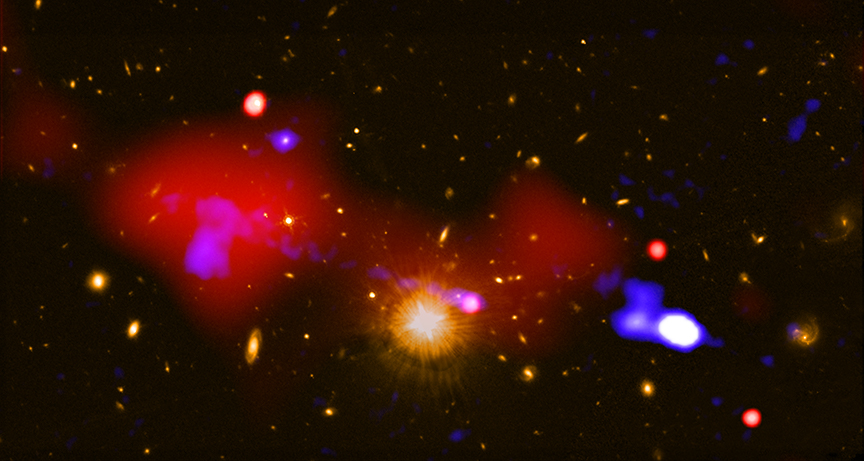
 Credit: X-ray: NASA/CXC/INAF/R. Gilli et al.; Radio NRAO/VLA; Optical: NASA/STScI
Credit: X-ray: NASA/CXC/INAF/R. Gilli et al.; Radio NRAO/VLA; Optical: NASA/STScI
Birth by Black Hole
Black holes are usually thought of as very destructive objects. Black holes form when matter is crushed to such high densities that its own gravity squeezes it so much that it, in effect, occupies no space. This forms a singularity that is not directly observable (if indeed it really exists). The singularity is shrouded by an event horizon, a region of space beyond which nothing, not even light (or any other form of electromagnetic radiation) can escape. Anything that falls into the event horizon is completely lost to our Universe. But black holes can also destroy objects outside the event horizon. As matter spirals into the event horizon, an extremely powerful particle jet is formed, blowing away matter for huge distances from the black hole. Astronomers sometimes call this "destructive feedback", since the particle jet can heat gas surrounding the black hole, making it too hot to form stars. However, in some cases, the presence of a black hole and its particle jet might be able to increase the stellar birthrate. The image above is a composite radio, optical and X-ray image of a group of glaxies. The low-energy radio emission (seen by the Jansky Very Large Array) is shown in blue, and shows the emission from the ends of the particle beam produced by a supermassive black hole at the center of one of the galaxies. The high energy X-ray emission (seen by the Chandra X-ray Observatory), shown in red in the image above, emphasizes the extremely hot, million degree gas heated by the collision of the black hole's jet with surrounding galactic gas and dust. Since this image is about 3.4 million lightyears across, the JVLA and Chandra images show that the particle beam from this supermassive black hole affects the galactic environment over enormous distances (more than 100,000 times the size of the event horizon). But observations also show that the pictured galaxies have high rates of star formation. Evidently the black hole's particle beam helps spur star formation somehow. Astronomers think that, as the particle beam moves through the intergalactic medium, it creates a hot bubble which compresses gas and dust along its boundary. Such compressed regions are fertile sites for star formation. This is believed to be an example of a particle beam producing "positive feedback", which helps promote the birth of new stars.
Published: January 6, 2020
<
HEA Dictionary ● Archive
● Search HEAPOW
● Other Languages
● HEAPOW on Facebook
● Download all Images
● Education ● HEAD
>

Each week the HEASARC
brings you new, exciting and beautiful images from X-ray and Gamma ray
astronomy. Check back each week and be sure to check out the HEAPOW archive!
Page Author: Dr. Michael F. Corcoran
Last modified Monday, 26-Feb-2024 17:09:54 EST


